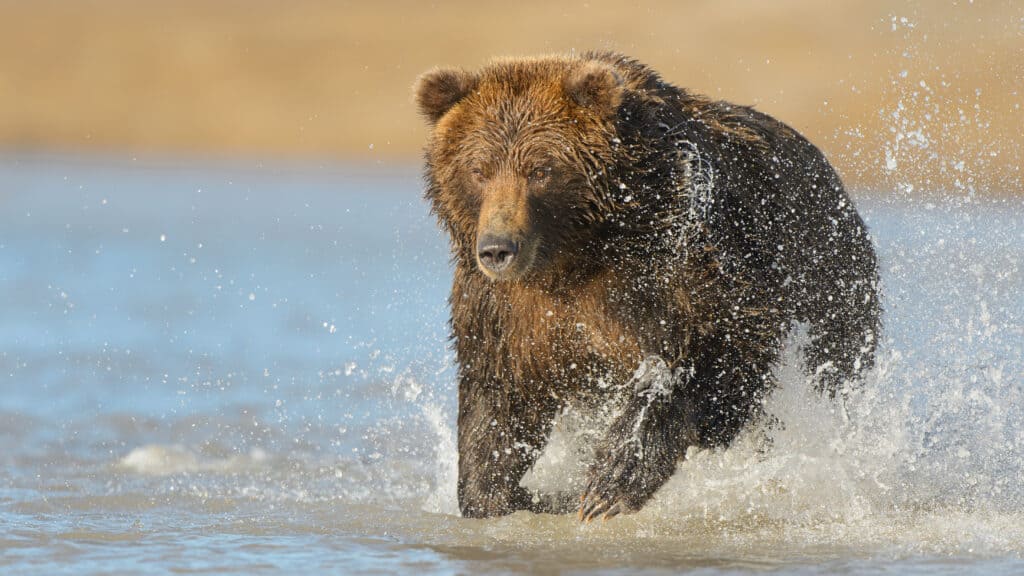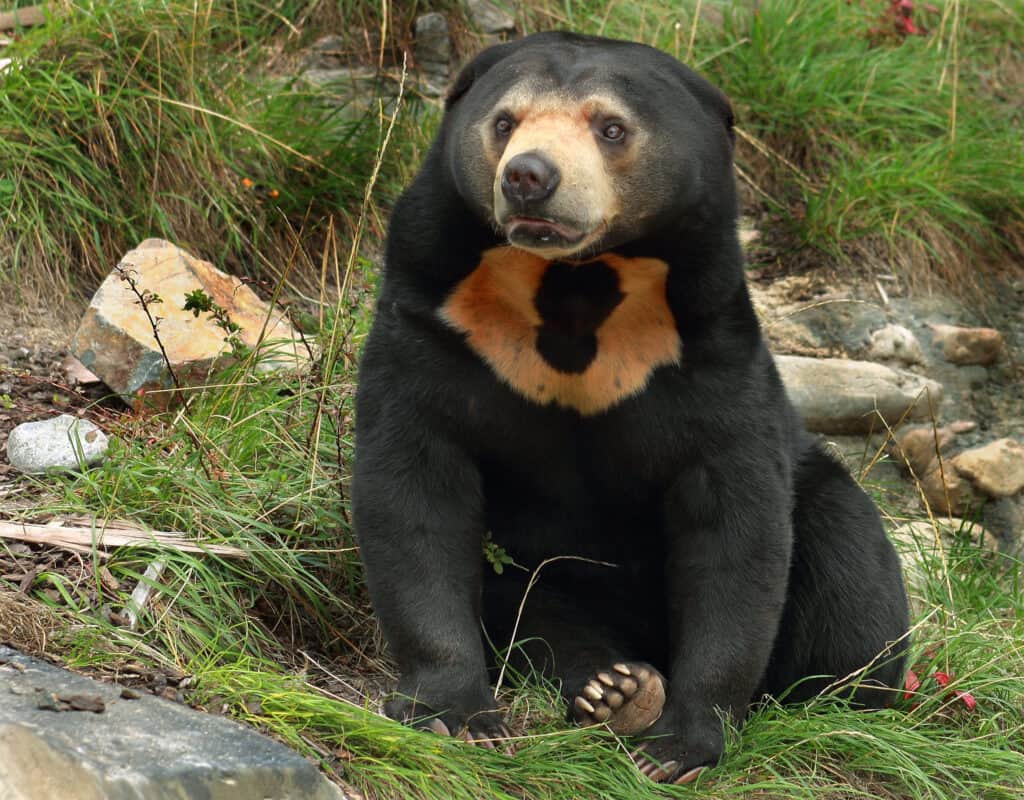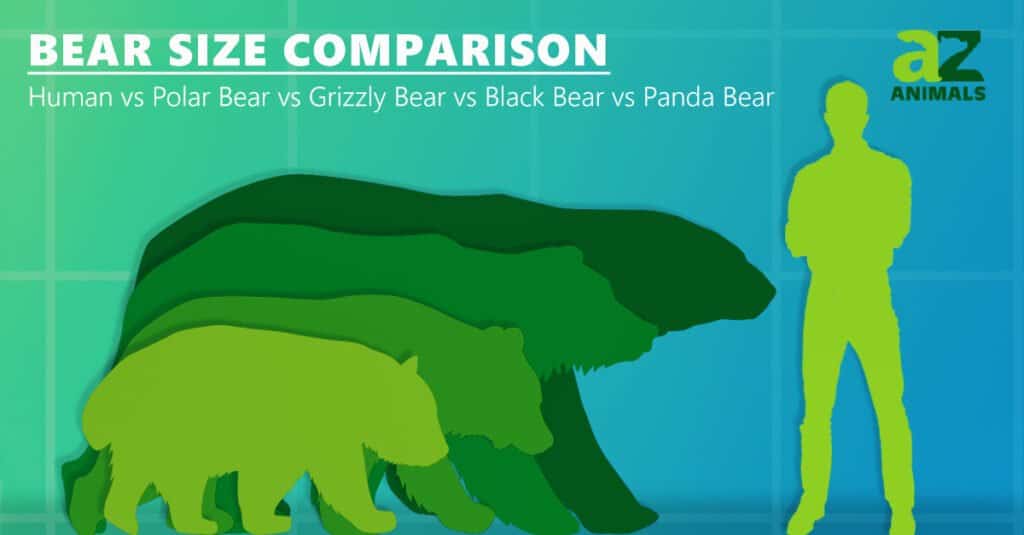Polar bears are known for their strength and athleticism, but they’re quite speedy, too! Below, we’ll take an in-depth look at just how fast a polar bear can run. In addition, we’ll compare its top speed to that of other types of bears, including the grizzly, brown bear, black bear, and even the panda. Read on to learn all about their running and walking speeds. Finally, we’ll touch on some interesting facts about each respective species!
How Fast Can a Polar Bear Run? Its Top Speed

Polar bears (
Ursus maritimus) are strong, adept predators and capable runners. They are also the largest type of bear on the planet.
©Vaclav Sebek/Shutterstock.com
A polar bear’s top speed is frighteningly swift. The average young adult polar bear can sprint at up to 25 miles per hour or around 40 kilometers per hour.
These sprints are usually short, however. This is because it takes a lot of energy to run due to the polar bear’s massive size, lumbering gait, and hefty weight anywhere from around 350 to 900 pounds. Especially large polar bears can exceed 1,200 pounds. Younger adult polar bears tend to be faster than older bears, as they are typically much leaner.
By comparison, a polar bear’s average walking speed is only around three to four miles per hour, or roughly 4 to 6 kilometers per hour. To be clear, the average polar bear isn’t just regularly zooming about at 25 miles per hour daily! Instead, they generally walk around at a much slower pace. This is so they can carefully save most of their energy for very short yet physically strenuous hunts for prey.
How Fast is a Polar Bear Compared to a Grizzly Bear?

Grizzly bears are the fastest members of the Ursidae family. However, they are slightly smaller than polar bears.
© NaturesMomentsuk/Shutterstock.com
Next, let’s compare the polar bear’s top and average walking speeds to that of the average grizzly bear, taxonomic name Ursus arctos horribilis. It turns out grizzlies and polar bears are quite comparable to one another in speed, despite the contrast in their overall size!
As we touched on above, polar bears are the largest and among the fastest known bear species. Their top speed is an impressive 25 miles per hour (or about 40 kilometers per hour). Still, grizzlies outmatch them significantly. As the fastest member of the Ursidae family, the grizzly bear can run up to 30 to 35 miles per hour (or 48 to 56 kilometers per hour) during short sprints.
However, like their polar bear brethren, grizzlies can’t sustain these speeds for longer than a few minutes at a time. Due to their similarly bulky builds and lumbering gaits, they usually walk at a much more leisurely pace: 1 to 2 miles per hour, or about 2 to 3 kilometers per hour.
All things considered, grizzly bears are almost 1.5 times faster than polar bears, both when running and walking.
How Fast is a Polar Bear Compared to a Kodiak Brown Bear?

As the largest type of bear aside from the polar bear, the Kodiak
brown bear
(
Ursos arctos middendorfi) is also incredibly fast for its bulky, stocky size.
©iStock.com/Jess Bray
Next, we’ll compare the polar bear’s running and walking speeds to that of a Kodiak brown bear. First, though, it’s worth clarifying what a Kodiak brown bear is taxonomically.
While many people believe the Kodiak brown bear is its distinct species, it’s a subspecies of the brown bear, Ursus arctos. As its common name implies, its geographic range is limited to Alaska’s Kodiak Islands. Notably, the aforementioned grizzly bear is also a subspecies of the brown bear. However, its respective geographic range consists of much of the rest of North America.
Like the grizzly bear, the Kodiak brown bear could also be considered one of the fastest bears on the planet. Its top running speed–albeit in short sprints–is around 35 miles per hour or about 56 kilometers per hour! Usually, though, they walk at just 2 to 3 miles per hour or 3 to 5 kilometers per hour.
All in all, this makes Kodiak brown bears around 1.5 times faster than polar bears.
How Fast is a Polar Bear Compared to a Black Bear?

Black bears aren’t the fastest runners of the Ursidae family, but they are very speedy climbers.
©BGSmith/Shutterstock.com
Let’s move away from brown bears to compare the polar bear’s running and walking speeds to that of a black bear, taxonomic name Ursus americanus. Although black bears aren’t quite as speedy as brown bears, their top speed still slightly outmatches the polar bear’s. To clarify, the average black bear’s top speed clocks in at around 25 to 30 miles per hour.
Like the other bears mentioned here, however, they rarely run this quickly unless they’re actively hunting prey. Still, the black bear’s agility and climbing skills are worth mentioning here. Many sources estimate they are capable of vertically climbing 100 feet of tree distance in as little as 30 seconds! Their large, strong paws and thick, curved claws make digging into and climbing trees a breeze.
As far as their walking and running speeds go, though, black bears are only slightly faster than polar bears overall.
How Fast is a Polar Bear Compared to a Sun Bear?

The average sun bear (
Helarctos malayanus) is only around 60 to 140 pounds at most, making it the smallest bear species.
©Molly NZ/Shutterstock.com
The sun bear is a lesser-known species as far as bears go, but the smallest member of the Ursidae family is still quite an adept runner. They’re also about on par with a black bear or polar bear in terms of their running speed. On average, the sun bear can run at speeds up to 30 miles per hour (or 48 kilometers per hour) in short sprints.
Despite their small size, this makes sun bears slightly faster than polar bears, albeit not by much.
How Fast is a Polar Bear Compared to a Panda Bear?

Panda bears, along with sloth bears, are among the slowest bear species.
©iStock.com/dangdumrong
The giant panda bear (Ailuropoda melanoleuca) is certainly an outlier here due to its slower speed, but it’s worth mentioning just for fun! As the slowest bear we’ll discuss here, the panda bear’s top running speed clocks in at around 20 miles per hour (32 kilometers per hour). Fortunately, though, their mostly vegetarian diet of bamboo means they don’t need to be able to sprint at 30-plus-mile-per-hour speeds.
All in all, this makes panda bears slightly slower than polar bears. Aside from perhaps the sloth bear, it is one of the slowest types of bears on the planet.
How Fast is a Polar Bear Compared to a Human?

Finally, let’s take a look at the polar bear’s running speed compared to that of a human. The fastest human sprinting speed ever recorded was 27.78 miles per hour or 44.72 kilometers per hour. This eye-watering record was set by Jamaican athlete Usain Bolt at the 2009 World Championships in Athletics. However, the average human’s running speed is much slower, with most adults clocking in at anywhere from 6 to 15 miles per hour.
All things considered, this means an athlete like Usain Bolt could potentially just barely outrun a polar bear for a short period. On the other hand, the average human would be vastly outmatched!
Top Bear Speeds: Recap
| Bear Species | Top Sprinting Speed |
| 1. Kodiak brown bear | 35 mph (56 km/h) |
| 2. Grizzly bear | 30 to 35 mph (48 to 56 km/h) |
| 3. Black bear | 25 to 30 mph (40 to 48 km/h) |
| 4. Sun bear | 30 mph (48 km/h) |
| 5. Polar bear | 25 mph (40 km/h) |
| 6. Panda bear | 20 mph (32 km/h) |
The photo featured at the top of this post is © Vaclav Sebek/Shutterstock.com
Thank you for reading! Have some feedback for us? Contact the AZ Animals editorial team.






